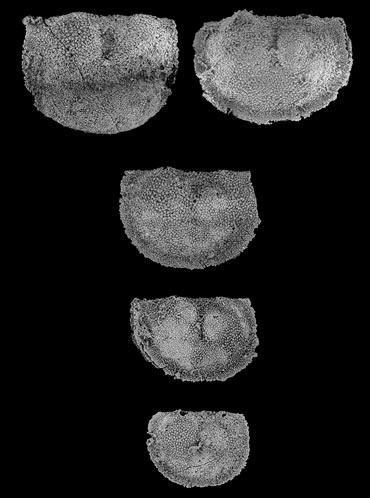Japan's earliest 'couple' identified
Scientists have discovered fossils of tiny male and female crustaceans over 400 million years old in Japan
An international team of scientists has discovered what is believed to be Japan’s earliest 'couple' – in fossil form.
The scientists, led by the University of Leicester, have discovered fossils of male and female shells of tiny bivalved crustaceans, just 1 mm long, in rocks more than 400 million years old from southern Japan.
The crustaceans in question are ostracods, a group that are abundant in a wide range of aquatic environments both today and in the past, with a fossil record of at least 500 million years. Umi-hotaru (海蛍), the 'sea-firefly', is a famous but only one of many ostracods common in the seas around Japan today.
The discovery was made in rocks some 423-433 million years old, belonging to the Silurian period of geological time, from the Kyushu and Honshu regions of Japan. It is the first record of ostracods from the Silurian of Japan and Japan’s earliest known ostracods.
 Professor David Siveter, lead author, from the University of Leicester, made the discovery, working together with Dr Gengo Tanaka (Kanazawa University, Japan) and colleagues from Leicester and Tallinn (Estonia) universities.
Professor David Siveter, lead author, from the University of Leicester, made the discovery, working together with Dr Gengo Tanaka (Kanazawa University, Japan) and colleagues from Leicester and Tallinn (Estonia) universities.
The discovery forms part of a larger research project that is shedding light on the early life forms and geological history of Japan.
Professor Siveter, from the University of Leicester’s School of Geography, Geology and the Environment, said: "There is an extensive history of studies on ostracods from Japan and Japanese scientists have made distinguished contributions researching living and microfossil representatives of the group. Our team has added to such studies by discovering three new ancient ostracod species which show presumed male and female sexual differences of the shell in tiny fossils, each about a millimetre in size, which were recovered from some of the oldest fossiliferous and intractable rock in Japan."
"This is an exciting discovery. It extends the known cases of 'sex' in fossils from Japan by at least 280 million years. It is also a happy coincidence that, as recently reported in the news, the current record for the world’s oldest living couple is held by a Japanese husband and wife, Masao and Miyako Matsumoto, who have a combined age of 208 and were married in 1937."
To mark the significance of the find, the researchers have named one of the new ostracod species Clintiella antifrigga, alluding to this ancient example of sexual dimorphism. The species name 'antifrigga' is derived from the Latin words antiquus, meaning ancient, and Frigga, the goddess of marriage.
The research is published in the journal Island Arc, as a part of a special issue documenting new discoveries of some of the earliest fossils known from Japan.
Professor Siveter’s co-authors are Dr Gengo Tanaka (Kanazawa University), Professor Mark Williams (University of Leicester) and Dr Peep Männik (Tallinn University). Funding was from The Leverhulme Trust (grant to Professor Williams) and the Ministry of Education of Science, Government of Japan (grant to Dr Tanaka).
- Reference: Siveter, David J., Tanaka Gengo, Williams, Mark, Männik, Peep. 2018. Japan’s earliest ostracods, Island Arc. https://doi.org/10.1111/iar.12284